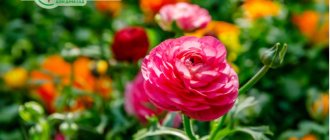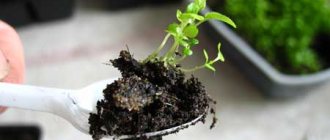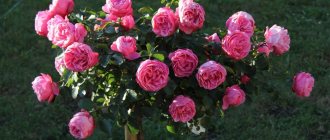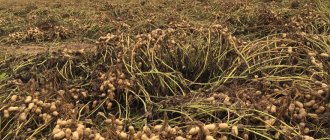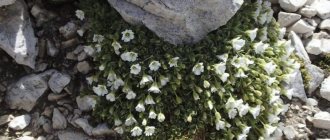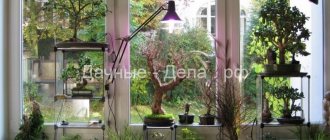Lavender is a perennial shrub that has become famous for its delicate aroma of essential oil, which has a relaxing effect and medicinal properties. In addition, the smell of the plant is not tolerated by moths and mosquitoes. Thus, dried flowers are used in everyday life to fill sachets for the wardrobe and protect the room from the penetration of blood-sucking insects.
The plant's homeland is the Mediterranean, and therefore lavender is very heat-loving and somewhat picky about environmental conditions. To grow a bush on a windowsill, the gardener will need to make some efforts to create a favorable atmosphere, but it is worth it for the delicate flower to become a decoration of the home interior.
Can it be grown?
Due to the fact that lavender is a heat-loving shrub, it is possible to grow it at home in a pot, but provided that the plant receives enough sunlight and water, and the room is warm and there are no drafts.
This is what lavender looks like and blooms in a pot:
Suitable species and varieties
Not all varieties of lavender are suitable for planting at home. The culture must be heat-loving in order to feel comfortable at room temperature.
There are more than 30 types of lavender, but the most popular are three varieties :
- narrow-leaved (English);
- broadleaf (French);
- hybrid (Dutch).
The first two types are most suitable for planting in a pot. They usually bloom from May (June) to August.
The most suitable crops for growing at home are the following varieties:
- Sweet;
- Munstead;
- Dwarf Blue;
- Peter Pan;
- Silver Blue;
- Sharon Roberts;
- Lavender Lady.
If you follow the growing rules, these varieties adapt perfectly to indoor conditions , delighting their owners with beautiful flowering and delicate aroma.
How to grow lavender at home
An infusion of lavender flowers is widely used in folk medicine, both internally and externally. Therefore, growing such a useful plant is a must-have for experienced gardeners, and will not be difficult with proper care.
There is no fundamental difference between growing at home and in a summer cottage. However, lavender in a pot at home becomes more finicky and requires careful daily care. Broad-leaved lavender is most adapted to home cultivation.
Store-bought soil is not suitable for it. The owner will have to make it himself from a mixture of sand, manure and soil with leaves. Proportions 1:2:3.
Planting is done by seeds or cuttings. Regular watering, fertilizing during the flowering period and placing the flower on the correct side relative to sunlight are also encouraged. An abundance of sunlight, as well as regular ventilation as often as possible, is a prerequisite.
In summer, you can even take the pots out onto the balcony; in this case, the lavender will thank the owner with lush flowering.
Important! In winter, the flower needs to be put into a state of rest: cut off old branches, ensure distance from heat sources and reduce the frequency of watering.
The necessary conditions
Growing live lavender at home is not an entirely simple task, since you need to comply with a number of requirements for the plant to feel comfortable, actively develop and bloom.
The soil
To begin with, the crop must be provided with suitable soil .
In nature, lavender grows on alkaline soils with a predominance of sand. Therefore, it is necessary to add coarse river sand to the soil mixture for the pot.
In general, the plant requires loose, light, alkaline and breathable soil . Acidic soil is not suitable for growing. You can buy the finished mixture in the store, or you can prepare it yourself from:
- sand;
- humus;
- turf or leaf soil.
All components will need to be mixed in a ratio of 1:1:2 . Before a crop is planted or sown in the soil, it will need to be sifted to remove debris and large lumps, and then disinfected with potassium permanganate.
To make the soil loose and breathable, you should add a little fine crushed stone to it.
Potty
One of the important attributes for growing lavender at home is a pot.
It should be wide and deep enough, since the plant has a deeply penetrating, tap root system that needs space to develop.
The minimum depth of the container should be 12-14 cm , the minimum diameter should be 30 cm, and the volume should be at least 2 liters. The pots can be any shape (rectangular, square or round).
It is advisable that the container be made of ceramic or clay.
If the container is selected for sowing seeds, then it must have sides at least 7 cm high . In the future, the lavender will need to be replanted and you will need to take a container approximately 7 cm larger in size.
The larger and more spacious the pot, the more opportunity the plant has to grow and develop.
To grow lavender outdoors, you need to select pots made from weather-resistant materials. For example, containers made from :
- ceramics;
- concrete;
- clay;
- gypsum
If metal flowerpots are used, they must be enameled or stainless. Wooden containers must have a waterproof coating.
In what places does it grow?
Lavender in a pot can be grown in three places:
on the windowsill;- on the balcony (loggia);
- on the street.
If the plant will grow indoors, then you should choose windows located on the south or southwest side - in this case, the crop will receive enough light and heat.
But in winter, lavender bushes, even on a southern windowsill, will lack sunlight , so at this time they will need additional illumination with a fluorescent or phyto lamp.
The bush should be in the light:
- in winter about 7 hours a day;
- in summer - at least 12 hours.
also important to regularly ventilate the room so that the plant receives a sufficient amount of oxygen , but this should not create a draft.
As for temperature, these indicators are different for each variety. But, as a rule, lavender does not tolerate temperature drops from +5 ̊C. During active growth and development, especially in summer, it prefers moderate temperatures from +18 to + 20 ̊C. She doesn't like heat. To ensure optimal performance in summer, it is worth humidifying the air in the room or taking the plant out into the fresh air.
As a rule, the plant is taken out to the balcony or street in the summer . At the first return frost, it is better to bring it into the house or leave it on a glazed balcony (loggia), covering the bush with spruce branches.
When growing potted lavender outdoors, it is also important to choose a sunny and warm place, since the crop does not grow well in the shade.
Lighting requirement
The plant is demanding in terms of lighting; if there is not enough light, it will not bloom luxuriantly.
In an apartment it should be kept on a south-facing window. If there is too much light and bright rays of the sun, you should remove the flower to a shady place in the room. In summer, a container with lavender is taken out to an open loggia, terrace, or courtyard.
In our country, daylight hours decrease with the onset of winter, and daylight for the flower becomes insufficient. In winter, the plant is illuminated using fluorescent and special phytolamps for at least 8-9 hours a day.
Which planting method is better to choose?
There are several ways to plant lavender:
- seeds;
- cuttings;
- layering;
- seedlings.
Each of these methods has its own characteristics, pros and cons.
Cuttings
The essence of this method is to separate shoots from an already mature bush and make cuttings from them, which will later be planted in the ground. To implement this planting technology it is necessary :
- Cut annual shoots from an adult bush.
- Divide them into small pieces, 10 cm long.
- Cut off the lower part (it will take root) at an angle of 45 degrees and treat it with a root formation stimulator.
- Plant the cuttings in a mixture of sand and peat (1:1 ratio), cover with film and leave until rooted.
- After the roots appear, prepare containers: take pots (preferably clay), with a diameter of 25-30 cm, and place drainage on their bottom (nut shells, sawdust, small shards or pebbles are suitable).
- Prepare the soil: mix leaf soil, humus and sand with a small amount of lime in a ratio of 3:2:1.
- Pour the soil mixture into the pots.
- Plant rooted cuttings.
The advantage of this method is:
- its simplicity;
- no need for special knowledge or experience;
- seedling survival rate and flowering rate (the next year after planting).
However, the disadvantage of this method is that to obtain a cutting you need an adult plant.
Seeds
To grow lavender this way, you will need:
container for sowing;- pots for replanting;
- lavender seeds;
- mulch;
- drainage;
- spray.
To begin with, the seeds must be stratified to increase seed germination. They are usually stratified in the refrigerator. To do this you need :
- Take non-woven napkins or cotton pads.
- Place the disk (or napkin) on the bottom of a container with a lid.
- Sprinkle the seeds onto it, covering with a second disk.
- Add a little water and drain off excess liquid.
- Leave the container for 2-3 days in a warm place for the seeds to swell, and then put it in the refrigerator.
The first shoots will appear in about a month. They can be planted when about a quarter of all seeds have sprouted. To do this, you need to prepare containers and soil, and then start sowing seeds :
- The container must be filled with soil mixture and leveled.
- Moisten the soil with a spray bottle.
- Plant the seeds to a depth of approximately 3 mm, at a distance of 1.5-2 cm from each other.
- Lightly sprinkle with soil.
- Cover the container with a lid or film.
- Place the container in a well-lit, warm place.
Seedlings need to be provided with light moisture by periodically spraying the soil . If all conditions are met, the first shoots will appear in a couple of weeks. In this case, the film will need to be removed and the containers moved to the brightest place.
When the seedlings have 3-4 true leaves, they will need to be picked.
Plants must be replanted very carefully so as not to damage the root system.
The advantage of this method is the ability to grow a plant from the very beginning, knowing exactly its variety, how the seedlings were grown and how they were treated (when purchasing ready-made planting material, there is no such certainty). However, this is the most labor-intensive and time-consuming method (you will have to wait 2 years before the first flowering) of growing lavender, the end result of which will not always be successful.
Seedlings
Typically, this method is used if the lavender was purchased in a store ready-made, that is, in the form of seedlings.
Also, the technology of planting seedlings in this way is suitable if the lavender was grown from seeds. As a rule, such bushes are small in size, so you must first select small pots for them , 3-4 cm larger than the earthen ball.
To plant lavender using this method, you need:
- Pour drainage (gravel or expanded clay) into the bottom of the selected container, carefully placing it so as to leave the holes open. Then the watering water will not accumulate in the pot, and there will be air from below.
- Pour soil into the container.
- Make a hole and water it.
- Plant the bush in the hole and sprinkle it with soil mixture.
- Water with growth stimulator Zircon.
This method is distinguished by its simplicity (especially if the seedlings were purchased and not grown independently) and quick results (the plant will soon take root and will delight in flowering).
By layering
Cuttings are the outermost shoots of a lavender bush that were intentionally rooted into the ground. The planting technology in this way is as follows :
- In March or April, the shoot must be bent to the ground and secured with a wooden or metal slingshot.
- Sprinkle the area in contact with the ground and moisten.
- At this time, roots begin to form on the layering. The rooted area is separated from the mother bush after about 2 months.
The advantage of this method is reliability, low labor intensity and good results.
The simplest planting methods are to grow lavender using cuttings or seedlings (if it was purchased in a store) - they do not require special knowledge, time and effort, but you can get the first flowers the next year.
Varietal diversity
Today, many varieties of lavender are known, each of which is characterized by certain characteristics.
English
This is the most popular type of lavender. The height and width of the bush can reach 1 meter. The exception is dwarf species, which grow a maximum of 30 centimeters. Flowering time is June-July.
Dutch
This is a hybrid variety that is characterized by low cold resistance. This is a fairly large crop, which in natural conditions can reach more than 2 meters. It is characterized by large inflorescences. Flowering begins in July.
French
This plant is considered the ancestor of ornamental varieties. It is characterized by various shades of flowers. The disadvantage of the culture is considered to be an unpleasant odor.
Narrow-leaved
This plant reaches 30 centimeters in height. The inflorescences are on long stems, which are covered with narrow gray-green leaves.
Serrated
This crop is a small bush that has large flowers and silvery leaves. This plant is considered heat-loving. Therefore, it is usually grown indoors.
Woolly
This crop is characterized by leaves covered with fluff. Thanks to this, they evaporate less moisture and tolerate dry periods more easily. At the same time, lavender does not easily tolerate waterlogging. If moisture stagnates in the container, there is a risk of the bush dying.
See also
Schefflera varieties and home care, growing rules
broadleaf
This variety has excellent decorative properties and contains many essential oils. For your home, you can choose varieties Christiana, Blue Cushion, Blue Ice.
Multi-notch
A distinctive feature of the plant is its triple inflorescences. In addition, it is characterized by fern-like leaves.
Petiolate
This bush is characterized by peduncles no larger than 50 centimeters. The flowers have a rich purple color. Under natural conditions, this variety is grown in Spain, Turkey, and Portugal. In Russia, the crop is usually planted in pots.
Stekhadskaya
This plant reaches 30-100 centimeters in height. This lavender begins to bloom earlier than others. This happens in March-June. At the end of summer the plant may bloom again.
Transfer
Lavender requires systematic transplanting from one pot to another - in this case, the root system will fully grow and not rest against the bottom of the container.
When should it be carried out?
It is recommended to carry out the procedure every year until active growth begins.
However, the option of replanting is possible at any time (even during the flowering period) , if the crop is provided with proper care, high air humidity and moderate temperature.
Transplantation is necessary to rejuvenate the plant and increase its growth rate.
You can understand that lavender needs to be planted in a larger pot by the appearance of the bush - a large number of new shoots can be seen near the edge of the container, and the lavender has slowed down its development and growth.
What kind of soil and container is needed?
When replanting a bush, choosing a suitable pot, you need to start from the size of the root system . The new container should be 5-7 cm larger than the previous one, and the roots should not reach the walls of the container. This will allow the powerful lavender roots to develop normally.
The minimum diameter of the pot is 30 cm and the volume is 2 liters. The depth should be such that the rhizomes can develop freely until next year. The depth must be greater than the diameter of the container. Also, do not forget that lavender grows better not in plastic containers, but in natural ones (ceramic, clay). The holes for water in them should be either frequent or large.
As for the soil, the plant should still choose light, non-acidic alkaline soil. It is recommended to prepare your own soil mixture consisting of :
- universal flower soil;
- a small amount of lime or wood ash (1-2 tsp);
- sand;
- peat
Technology
To transplant lavender to a new place, you will need:
- Suitable size pot.
- Drainage (expanded clay).
- Soil mixture.
- Growth stimulator Zircon (for watering after transplantation).
First you need to prepare the pot:
- Make drainage: pour expanded clay onto the bottom of the pot in a layer of 2-4 cm.
- Fill in some of the soil mixture and make a hole corresponding in size to the diameter and depth of the previous lavender pot.
Then the transplant itself is carried out, for this you need:
- Remove the lavender from the old pot. It will come out easier if you turn it upside down and spill the soil with water before doing so.
- Plant the bush in the prepared hole so that the surface of the soil of the previous pot is not covered with new soil.
- Sprinkle with prepared soil mixture.
At the end you need to water the planted bush, for this you will need:
- Dilute the growth stimulator Zircon (take 10 ml of the product per 5 liters of water at room temperature).
- It is good to spill the soil around the edges of the pot.
- When the water has drained, fill the voids that appear with soil and lightly compact them.
Rules of care
In order for lavender to grow, develop and bloom well, it is necessary to provide it with the following care:
Loosening the soil . To ensure aeration, it is necessary to loosen the soil weekly.- Watering. Water the plant with soft, settled water. In the first couple of months after planting, watering is carried out 2-3 times a week, after which moisture is carried out as the soil dries.
Any water that has leaked out of the drainage holes must be removed immediately to prevent it from being absorbed back. To retain moisture longer, it is worth covering the soil surface with a layer of mulch made from sawdust or pine needles.
- Feeding . To improve the growth of green mass of bushes, it is necessary to apply nitrogen fertilizers twice a year. Also, during the flowering period, complex fertilizing is applied.
- Trimming . It is necessary not only for maintaining the decorative appearance of lavender, but also for better growth of healthy, young shoots. For this purpose, it is necessary to trim damaged and dry branches. The first procedure is carried out immediately after flowering has completed (the top of the bush needs to be slightly trimmed), the second - at the end of autumn (the shoots should be shortened by 1/3 and the bush should be slightly thinned, leaving a few green stems).
- Lighting . Lavender needs a lot of sunlight - for this reason it should be placed in a south or south-east window. If there is not enough natural light, it must be compensated by artificial lighting with a fluorescent lamp.
Queen of incense in a charming outfit
Lavender is an evergreen perennial from the Lamiaceae family. It is found naturally in India, the Canary Islands, Africa and Southern Europe. Cultivated species are grown even in countries with cold climates. The cute buds give lavender its unique beauty. They appear in mid-June and decorate flower meadows for 2.5 months.
The spike-like inflorescences are located on long shoots and sway gracefully in the wind. Each of them has from 6 to 10 buds. Depending on the variety, the petals are painted in the following colors:
- blue;
- blue;
- violet;
- pink;
- snow-white.
When the flowering period ends, dark brown seeds are formed on erect shoots. Lavender has a woody taproot. The leaf plates are narrowed ovals with a jagged or even frame.
During flowering, lavender meadows resemble a bright blanket that emits a unique aroma.
How to protect a flower from pests and diseases?
As a rule, at home, lavender is less susceptible to various diseases and pest invasions. She usually suffers from improper care. However, there are still some diseases and insects that can harm lavender bushes:
- Gray rot . It has the appearance of a white fluffy coating that appears on the shoots. Over time, small pockets grow and turn into gray-blue mold - during this period the death of the plant begins. At the initial stage of disease development, it will be necessary to spray the crop with copper sulfate or Hom. In later stages, medications will not help much.
- Powdery mildew . It appears as a white coating, which over time becomes covered with white droplets. With the formation of spores, the spots turn brown, and then a coating appears on the shoots and buds. To combat the disease at the initial stage, it is necessary to provide the lavender with better lighting and avoid waterlogging of the soil. Among the drugs that will help are Fitosporin, Baktofit, Alirin.
- Spider mite . They enter the house through an open window or shoes. A sign of their appearance is a light cobweb on the shoots. To get rid of mites, you need to treat the plant with Fitoverm.
In order to prevent the occurrence of diseases, it is necessary to ensure that the plant receives enough sunlight and that the soil is not over-moistened (or over-dried). It is recommended to fertilize to maintain and strengthen the immunity of lavender.
Possible difficulties
In general, growing lavender bushes at home is not difficult or problematic . However, there are some nuances that you should know about before planting a plant in your home.
At home
The main difficulty in growing lavender at home is that it is a “wild” plant that is not sufficiently adapted to growth and development in the limited space of a pot. Other difficulties and nuances are:
Always provide the plant with a spacious container - since lavender has a long central root, which should not rest against the bottom of the pot (otherwise it will stop growing).
Therefore, it is necessary to transplant it annually into deeper and freer containers.At the same time, the plant itself does not like to be constantly disturbed, so it tolerates transplants with difficulty. To reduce stress levels, the procedure must be carried out very carefully and during the bush’s dormant period.
- The need to provide the crop with an influx of fresh air - if the room is not ventilated regularly, it will begin to “suffocate” and stop growing.
- The need to monitor the maintenance of optimal humidity levels, since lavender does not tolerate waterlogging. It also does not respond well to soil drying out.
- Providing the required amount of light - in winter and cloudy days it is necessary to install additional lighting for the crop with a fluorescent lamp.
On the balcony and on the street
If the plant is exposed to fresh air in summer and spring (whether on a balcony or street), it is important that the lavender is not in the shade. Otherwise, its cultivation will become practically useless: the bush will develop poorly and will not bloom.
The main difficulty lies in wintering the crop . You should not leave the plant on open balconies (or in the garden) in frosty winters - there is a high probability that it will die. At +5 ̊C, lavender goes into a dormant state, so it is worth bringing it into the house at this time. Another option for wintering is to leave the crop on a glazed and unheated balcony (or loggia).
As with growing in an apartment or open ground, lavender in a pot on a balcony or street requires timely pruning, which should not be forgotten.
The main mistakes of novice flower growers
Despite the abundance of various instructions and tips, many new flower growers make common mistakes.
- Wrong choice of pot. A common misconception is that if a plant is small, it does not need a large container. This is not true. Lavender loves space, and it needs a lot of space for proper development of the root system.
- Violation of the light regime. For many, the knowledge that lavender does not tolerate heat well sounds like an alarm and caring owners hide the bushes from the sun in partial shade, forgetting that lavender does not like this either.
- In search of light in winter, the plant is placed on the brightest windowsill, where the temperature does not rise above 15°C.
- Afraid of overwatering the plant, beginners often dry it out. Drying out the soil has the same detrimental effect on the plant as too much water.
Advantages and disadvantages
The main advantages of growing lavender at home in a pot include:
Less susceptibility of the plant to various diseases and pests.- A pleasant aroma wafting throughout the house.
- Always have lavender at hand: for carrying out procedures or cutting branches (in a sachet, for taking a bath or creating a fragrant pad).
However, this option for growing lavender bushes also has a number of disadvantages:
- Easier to care for than when planted in open ground.
- Individual intolerance to the smell of lavender.
- The need for annual transplantation.
User reviews
The generalized pros and cons of growing were presented above, while gardeners on forums share more specific advantages and disadvantages of planting lavender at home.
So, they consider the advantages:
- Pleasant, calming aroma (if you place lavender in the bedroom, it helps improve sleep).
- Decorativeness of the bush.
- A wide range of uses: in cooking (as an additive to tea), in folk medicine (essential oil helps relieve pain from a burn, accelerates healing), in everyday life (put cut dried twigs in a closet to ward off moths).
And gardeners consider it a disadvantage:
- Difficult to grow from seeds.
- The need to ensure optimal conditions of detention (if any point is not met, the lavender dies).
The opinions of flower growers can be found here, here, on this forum, on the website and this resource.
Can the pot be reused?
Pots can be reused. This is contraindicated only if the plant in it suffered from incurable diseases, for example, root nematode or cucumber mosaic. The pot, freed from the previous flower, needs to be prepared in order to transplant a new plant into it: wash and disinfect.
Lavender can bloom and delight with its aroma not only in the garden or country house, but also at home. You just need to follow simple rules of care: choose a pot and plant it correctly, and then monitor the annual replanting.

